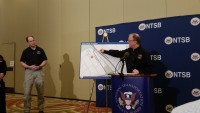NTSB on Metro-North Train Tragedy: Equipment Functioning, Procedures Followed

All equipment was functioning and proper procedures were followed leading up to Tuesday night’s fatal train crash, according to preliminary findings from the National Transit Safety Board.
Speaking from Tarrytown Thursday night, NTSB board member Robert Sumwalt stated the train involved in the accident, which left six dead and 15 injured, was traveling at 58 miles per hour as it approached the Commerce Street crossing; two miles under the 60 mile per hour speed limit.
Sumwalt stated that an interview with the engineer of the train had concluded just moments before he stepped up to the podium, and that all he knew so far was the engineer reported seeing the Mercedes SUV, driven by Ellen Brody,move onto the tracks. According to a preliminary review of the train’s event data recorder, the train sounded the proper cadence, two longs blasts of the horn followed by one short blast and another long blast, as it approached the crossing.
At approximately 6:27 p.m. the engineer engaged the emergency brake on the train. At this time, officials do not know how far from the crossing the engineer was when the brake was engaged, although a time-distance study will be done to determine that information.
Sumwalt stated that members of the NTSB had their first opportunity today to interview the driver who was in the car behind Brody’s at the time of the accident. The witness reported that he had entered onto Commerce Street after traffic had been diverted from the Taconic State Parkway due to a separate accident. When the witness approached the railroad crossing, he reported that traffic was “inching along” as the SUV moved onto the crossing and came to a stop. At this point, the crossing arm lowered onto the SUV and hit the back of the car; at which point the witness reported that he backed up to allow Brody to do the same. According to the witness, Brody got out of her car and walked to the arm, then got back into the vehicle and sat there for a moment “as if there was enough time to put on her seatbelt.”
Sumwalt stated that the NTSB downloaded the information recorded from the crossing’s warning system, which revealed that the arm, as well as the traffic signal at the nearby intersection which is synched to the crossing, were both working properly. Thirty-nine seconds before the train approached the crossing, the flashing lights illuminated and the arm subsequently lowered, said Sumwalt. The area had adequate signage indicating the railroad, including markings on the pavement and a sign reading “do not stop on the tracks,” said Sumwalt.
Going forward, investigators will look into factors that may have led to Brody getting stuck on the tracks. Sumwalt said they will try to determine whether or not Brody was familiar with the vehicle she was driving, her familiarity with the area of the accident, and if traffic in front of her prevented her from driving forward. In addition, the NTSB is in the process of obtaining her cell phone records, to determine if she was texting or making a call at the time of the accident.
“We do that routinely now in all transportation accidents because we have seen a lot of accidents where this is a factor,” said Sumwalt.
Investigators have yet to obtain any kind of recording device from the SUV that might give them more insight into the situation.
In the coming days, Sumwalt stated that members of the NTSB will interview the conductor of the train as well as the people who are responsible for maintenance of the third rail, which penetrated both the SUV and the first car of the train. The third rail was last inspected in December of 2014, according to Sumwalt. In addition, the NTSB will work cooperatively with MTA police to conduct a thorough inspection of the severely damaged first car of the train.
“This is a very detailed investigation of this car. We’re combing carefully through pieces of ash, debris, pieces of third rail that have penetrated into that rail car and it makes for a very lengthy investigative process because of the severe, burnt-out condition of that car,” said Sumwalt.
The NTSB is still asking for any witnesses to the crash who may have information to come forward by emailing witness@NTSB.gov. The MTA has also established a family assistance hotline at (718) 361-2402.

Examiner Media – Keeping you informed with professionally-reported local news, features, and sports coverage.
